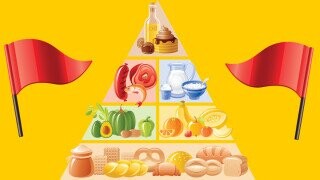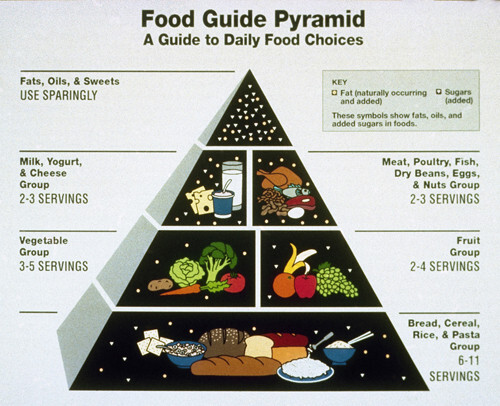How Red Flags Made Up the Food Pyramid

Ah, the calamity of the American food pyramid. A seemingly straightforward approach to achieving all your dietary needs -- that is if you understand gibberish. And if you pay attention to your health at all, then maybe, just maybe, some components of it felt off all along.
The disaster that was the creation of a highly structured way of eating left much to interpretation, and provided more confusion than clarity to most Americans. The invention of food guides in the 1940s originated with Harvard University and has today evolved into more lax territory. But what were the red flags that sprung this indigestible concept?

https://beagamecharacter.com/2013/03/19/exercise-vs-diet/
Don't Miss
As suggested by Healthway, “Part of the problem with the food pyramid was that it was too broad in its articulation of what constituted healthy choices.” Take, for example, the grains section of the official Food Guide Pyramid, released in 1992, which didn't specify what healthy grains really were. So… pancakes and brown rice? Processed sugar was thought to be a valid source of energy before soccer practice, as Snickers would insist time and time again.
One key character played a role in the 1992 Food Guide Pyramid’s structure, only her guidance varied drastically from what the USDA wanted on people’s dinner plates. Dr. Luise Light, the nutritionist who led the pyramid’s fabrication, was left in the dust after her pitch to the USDA wasn't received how she had hoped it would be. More than small changes were applied to her model upon revision from the government entity, from recommended serving sizes down to the very wording of the descriptions that would accompany images of the food groups. Take, for instance, her suggestion of incorporating 5 to 9 servings of fruits and vegetables daily, which the USDA conveniently bumped down to 2 to 3. The wording was also altered to emphasize that eating processed foods over fresh ones wasn’t as detrimental to health as it has proven to be over time. Reduced-fat dairy and lean meats were pushed to the wayside, with an unspoken nudge to encourage the consumption of full-fat meats and dairy for government profit.

https://www.huffpost.com/entry/usda-dietary-guidelines-diabetes_n_5635554
But what was the USDA’s motivation behind such actions? Were they trolling Dr. Light?
The USDA minimized the alternative, slightly healthier choices of lean meats and low dairy options, as a way to keep full-fat products, the more profitable items, skidding through the market. Healthier choices were not as profitable as “fun foods like junk food,” as Dr. Light explains in her 2004 report, A Fatally Flawed Food Guide. Seeing an apple in a commercial did not hit consumers the same way a vibrant fruit roll-up could. She notes that the USDA, “also hugely increased the servings of wheat and other grains to make the wheat growers happy.” Dr. Light also claimed that “the meat lobby got the final word on the color of the saturated fat and cholesterol guideline which was changed from red to purple because meat producers worried that using red to signify “bad” fat would be linked to red meat in consumers’ minds.” Similarly, Dr. Light’s original, straightforward wording of “eat less” was tailored and became “avoid too much,” to remain vague in reference to how frequently processed, sugary foods high in saturated fats ought to be consumed. This allowed for more money in the junk food industry’s pockets, because they weren’t creative enough to create an engaging ad for broccoli.
Yet this isn't the first time the government found itself entangled in some shady, snacky business. Just look back to the 1970s, when too much cheese was produced.

https://www.vice.com/en/article/wn7mgq/wtf-happened-to-government-cheese
It quickly became lucrative to be in the dairy business, as the country swept in to dominate rapidly changing milk prices. Into the '80s during Reagan’s presidency, cheese was everywhere, and too much of it. Nearly everyone almost became mice.

https://www.history.com/news/government-cheese-dairy-farmers-reagan
The American government decided to up the daily recommendation of how much dairy should be consumed, as a plot to get rid of it via the food pyramid and into the mouths of its people. The USDA took advantage of its population in an attempt to control its own mistake -- shocking. And on top of that, as Andrew Novakovic, professor of agricultural economics at Cornell University told CNBC, “People talk about food assistance programs as if they were created to help poor people out… Yes that’s true, but almost all of the major food assistance programs were ideas that came from agriculture because we had too much of something.”
If people have distinct lifestyles, ages, are prone to varying illnesses, and dispense their energy differently, how can one food guide fit all? Well, it was never truly meant to.
Top Image: Shutterstock/Shutterstock